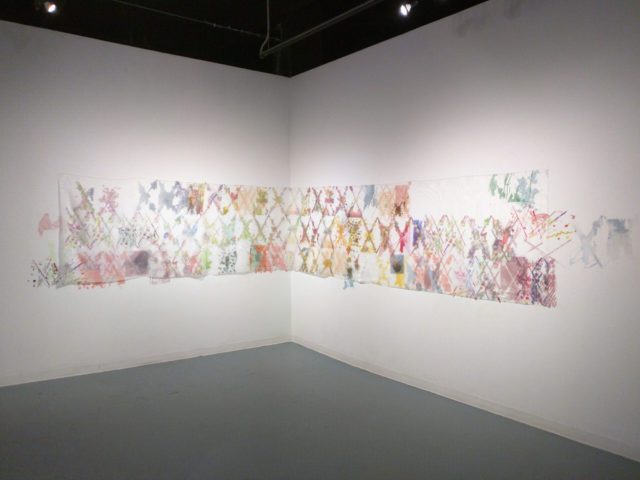
Eva Wylie, “Down The Line,” silkscreen on wall, 2016.
Eva Wylie: Down the Line
Presented by ICA Baltimore
SpaceCamp
16 W. North Ave,
Baltimore, MD
On view until July 1
I wasn’t quite sure how to photograph Eva Wylie’s mural “Down the Line,” which has been silkscreened directly on the wall at Space Camp. It’s most enjoyable in macro close-up, where the amount of meticulous labor and number of precisely-aligned layers of color are visible. But an image of these tiny images doesn’t really tell us much. They’re just mundane houseplants, crumpled blankets, or birds. Each individual panel could be a twee greeting card. Others areas appear to be based on out-of-focus photographs. Viewed in succession, they evoke a video collage more than a print. To fully appreciate the scope of Wylie’s undertaking, one must stand across the room, but then we’re presented with a chaotic, seemingly unfinished wallpaper with no apparent rhyme or reason other than an irregular grid of “X’ shaped compositions.

Eva Wylie, “Down the Line,” detail.
Whatever this thing is, I like standing in front of it. It’s best experienced up-close, walking slowly as if the piece were a series of sequential images to be “read” like a comic book or narrative fresco. But the only message I can come away with is that it’s a love letter to labor-intensive process and the studio. It’s an odd association for a site-specific work, but one that’s awkwardly comfortable for its context.
SpaceCamp is a tricky site for solo shows. The gallery is the approximate shape of a serif “L”, snaking back from a narrow storefront, next to and behind the Baltimore Print Studios. It feels too cavernous for all but the most prolific artist to fill with high-quality pieces and yet too compartmentalized for a sense of cohesion. On the other hand, it’s a fantastic venue for group shows, in part because its floorplan suggests a progression—and I’m sure a decades-spanning retrospective would be great here. Unsurprisingly, singular emerging artists—the curatorial specialty of the itinerant ICA—never quite seem to know what to do with the space. Solo shows tend to feel dwarfed, fluffed with repetitive “filler” pieces, or somewhat incomplete in SpaceCamp. But Down the Line seems to successfully exploit these challenging qualities: the architecture is engaged, small details are playfully lost in horror-vacui works that struggle against the void, motifs are repeated until they fade, and there’s an optimistic sense of unfinished business.
Searching out little details in the large works on the walls feels a bit like a game of “Where’s Waldo”—a celebration of things being overlooked. The exhibition is staged as a monument to process—specifically, the absurd amount of labor and materials that goes into printmaking. Wylie presents a pixelated montage of image/objects that feel precious, others that suggest a “work in progress”, and other still with an ambiguous identity as “art object” or production byproduct. Framed, intimately-scaled prints on translucent fabric share the space with ambitious site-specific work printed directly on the wall. In the center of the room, the unstretched silk used in producing the mural hangs limply between two pillars, holding barely-legible ghost images.

Eva Wylie, “Down the Line,” printed silk, 2016.
“Down the Line” is a bit of an anti-mural, rejecting monumentality and immediate legibility. The laborious works on the wall are of course impermanent. That’s a shame, really, because I could see this living outside near a bus stop far more successfully than so much obvious, one-dimensional, or didactic street art. It’s natural to want to slow down and spend time with this work, even as its form implies a procession to move the viewer along. There’s also an ambiguity of intent—do these snippets of imagery matter? Or are we supposed to merely marvel at how all these layers of ink can collectively form a coherent image? Is this spider plant or patterned blanket important to the artist? Should it be important to us?
The more I think about Wylie’s work, the less I care about those questions. I’m content knowing that the wall pieces are a pleasure to take in. And, like the best process-based artworks, make me want to get in a studio and play.

Eva Wylie, “Down the Line,” printed silk and silkscreen print on wall, 2016.


Comments on this entry are closed.